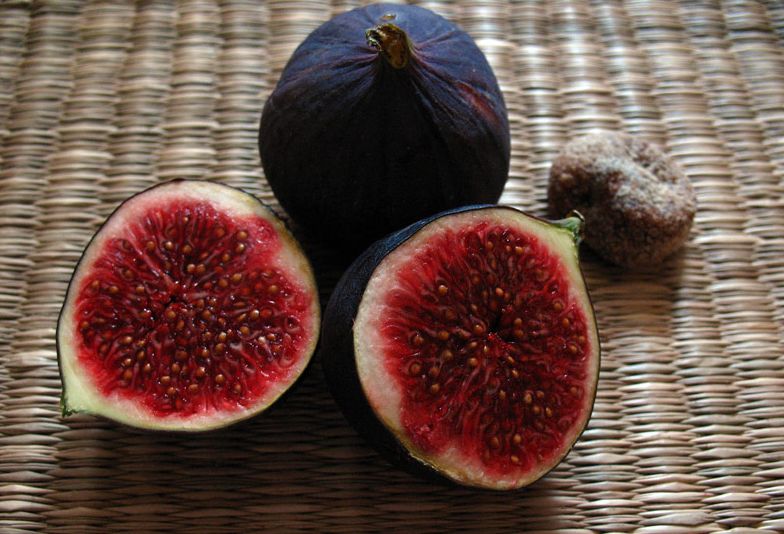The oldest fruit tree mentioned in history is undoubtedly figs. Its leaves were the first clothes of Adam and Eve, there is even a version that the tree of knowledge was not an apple tree at all, but a fig.
The history of the ancient world is inextricably linked with the cultivation of figs. In Greece, this fruit was a symbol of fertility (the number of fruit grains reaches 1000 or more).
The soft fig leaves replaced the napkins with the Romans ... By the way, the she-wolf fed the founders of Rome under the shadow of the fig tree. Until now, Italians consider figs to be the Christmas symbol of abundance.
In this article we will learn how the figs look (white and black), where it grows in Russia, as well as how to eat its fruits.
Table of contents
What is a fig, what does it look like and its other name
In another, figs call “ficus karika”. It is difficult to call this multi-stem tree up to 10 meters tall. The crown is spreading, the bark is gray, curved branches are covered with very large beautiful foliage.
The outer side of it is dark, from the bottom the leaves are much lighter, rough from small villi. Figs, like other figs, contain a very pungent milky juice.
Fruits of figs - with a very delicate skin, filled with sweet reddish jelly and small grains inside. In fruit, fermentation processes often begin right on the branches, hence the second name - “wine berries”.
The plant is dioecious, "male" and "female" inflorescences grow on different trees. How does a tree bloom? Flowers of a nondescript species grow in the leaf axils. Pollination occurs in a very specific way - wasps of a particular species develop inside the fig flower and when they fly out they tolerate pollen.
Due to the lack of natural pollinators (these wasps), figs could not acclimatize in America until they brought out special varieties for new growing conditions. Nowadays, industrial plantations of fig trees consist entirely of only such self-fruiting varieties.
How, where does the fig grow and blossom, how to determine its ripeness?
The plant is so unpretentious that it can grow not only on poor soils, but even on rocky scree and stone walls. No tillage before planting requires at all - neither cultivation nor fertilizer.
The fig tree propagates by seeds, root suckers, green cuttings. The plant easily tolerates shearing and pruning at any age. Fruiting figs starts early - for 2-3 years, starting from about 7 years gives a stable crop, lives up to 100 years (even 300 summer specimens are known).
The closest relative of the well-known ficus, figs grows sprawling shrubs or trees up to 10-12 meters tall. The plant is extremely tropical, even a temperature of -100 ° C is destructive for it, and frequent frosts on the Black Sea coast significantly damage the planting of the fig tree.
The specificity of the plant that figs are not terrible frosts themselves. Colds do not tolerate pollinating wasps wintering in fruits.
Unpretentious fruit tree with such tasty and healthy fruits became widespread in India, Australia and the islands of Oceania, the semi-deserts of Africa, in Central and Latin America, Bermuda and the Caribbean.
Since ancient times, figs grow in the Crimea, Transcaucasia and Central Asia. Greek colonists brought it to the Black Sea coast.
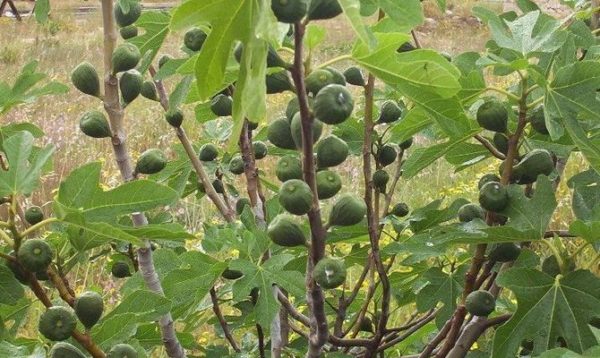
When are the berries harvested?
The most unusual in our understanding, on the branches at the same time are the figs of the current crop and the beginnings of the fruits of the next season. Moreover, these overwintering buds are ready for harvest at the end of May. They are much larger than the autumn harvest, but not so tasty.
The first harvest (insignificant) is harvested in June-July, and the main second crop in the fall, in September-October. However, in modern industrial plantings, cultivars with one-time fruiting are cultivated.
If the figs are designed to be dried, x are left on the branches a little longer, where they are dried and spontaneously dry almost to the required condition in natural conditions.
Varieties of short stature are now being developed, as well as varieties that are dried on the branches much faster. All this facilitates the production of valuable fruits.
Very tender berries can be stored for only a few hours, they need to be quickly processed or eaten fresh.
How to pick figs: green or ripe?
Figs as a thousand years ago are harvested only by hand. This is due exclusively to the very “delicate” structure of the fruit - the jelly-like pulp with small seeds is covered by a thin peel. From each tree the fruits are removed in several stages, as they ripen, choosing only ripe figs. Immature fruits cannot be eaten because they contain poisonous bitter "milk".
Fruits are collected not just very carefully. Fruit pickers must put on thick cotton gloves.
- so as not to damage the delicate wine berries,
- to protect yourself from the caustic sap of the plant.
Cut the fruits with a sharp pruner or knife, place them in low pallets, transfer them to shade and send them to consumers.
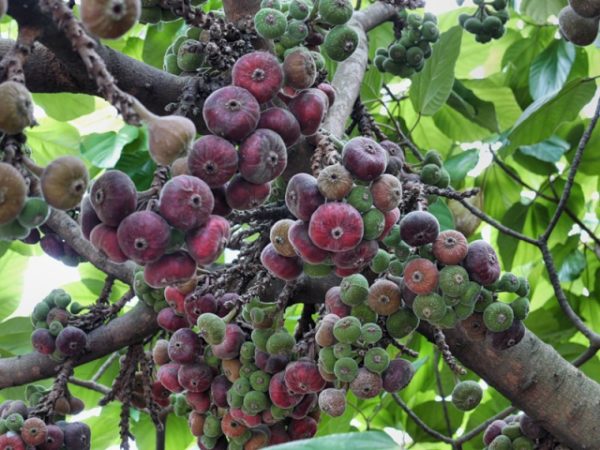
How to store and use the collected fruit of the tree?
Fresh fig fruit is stored for literally several hours. Given the high sugar content (up to 30% in fresh fruit), fermentation processes begin very quickly - no longer than 6 hours (hence the second name - “tartar”).
In the United States, a significant portion of the fig immediately undergoes deep freezing. Some varieties are well stored in 30-40% solution of sugar from cane at a temperature of -12about C in refrigerators. The main part comes to consumers in dried form.
For drying most often use light fruit from about to 5 centimeters. They are kept for 4-5 days under the rays of the sun.
The classic method of drying figs is under a canopy strung on a thread through a punctured stalk (in the form of "beads"). Sometimes it is dried by spreading the "eye" up, spreading it in the sun. Sometimes, before drying, the fruits of figs are dipped in hot syrup for a few seconds and then brought to a state of gas or sun.
Freeze figs with dark berries. It is pre-washed, dried, packaged and frozen. Store at-16-18 about With about six months. But this method of storage is not the most popular.
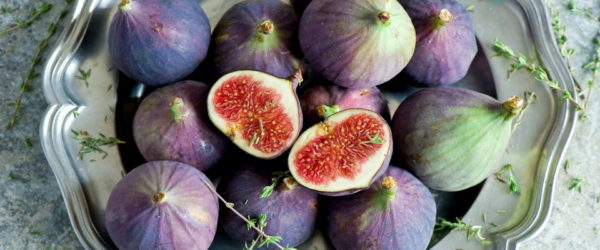
Useful properties of ripe fruit
Figs are not only tasty, but also very useful. In addition to pectins, organic acids, and vitamins (B, C, PP, beta-carotene), these fruits contain many minerals and trace elements. Potassium in figs is almost like nuts, and iron is more than an apple.
Recipes
To recuperate after an illness and just to raise the immunity, a “wonder mix” is recommended.
For its preparation it is necessary to take equal parts:
- dried figs,
- dried apricots,
- raisins,
- peeled walnuts.
All skip through a meat grinder and mix with the same share of honey. Keep refrigerated. Taking 1 tablespoon every morning is not only very tasty, but also supports the cardiovascular system, the digestive tract and the overall tone of the body.
In the southern countries, figs are processed into jam, marshmallow, and even high-alcoholic beverages are made from it. Of the products we have available, try making the original cookies.
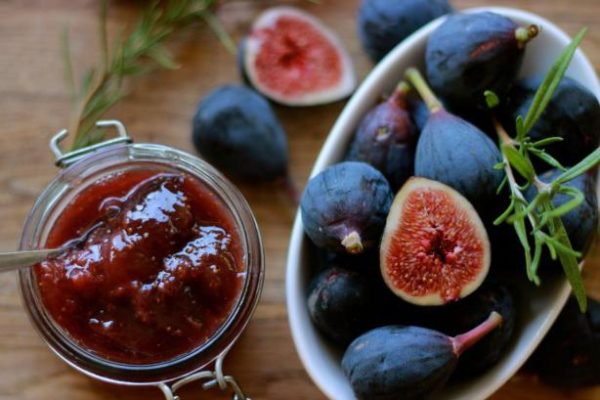
Required Products :
- 1/2 cup of granulated sugar
- 50 grams unsalted butter,
- 1.5 wheat flour,
- 1 chicken egg
- 1/4 cup milk
- 200 grams of chopped figs,
- 1 teaspoon of baking powder, vanilla sugar, lemon peel and its juice,
- a pinch of salt.
Preparing is very simple: mix everything and gradually stir the flour. Roll out the dough 1-2 centimeters thick. Cut into a glass, put on a baking sheet. Bake at 160about With about 15-20 minutes.
Conclusion
Fig - tree tropics and subtropics. Of course, it can be grown in a greenhouse, and even in the room to get a few berries. But all the useful properties are stored in dried berries, which can always be bought in the trade network.
And at home to grow another ficus ...
